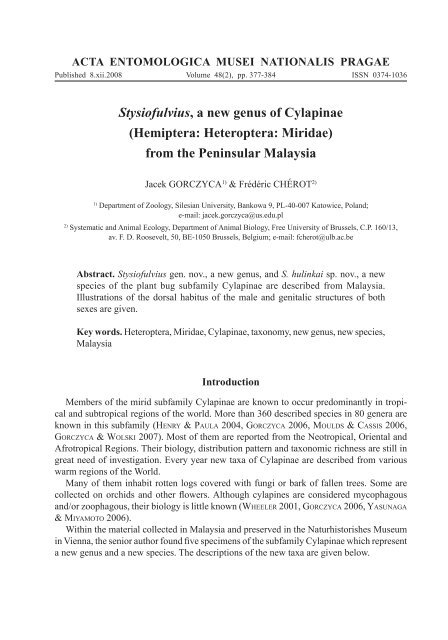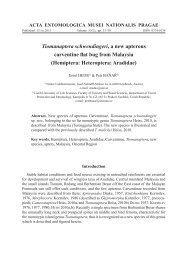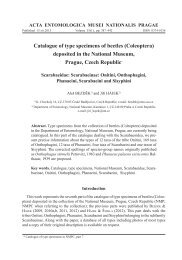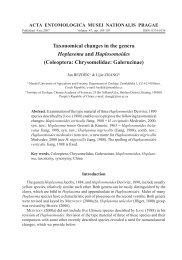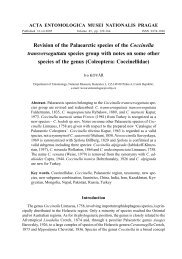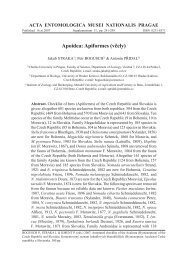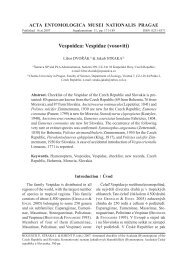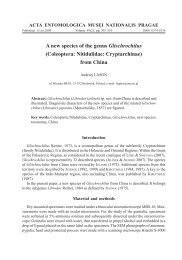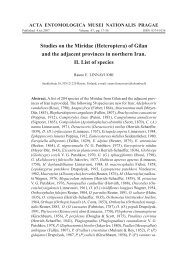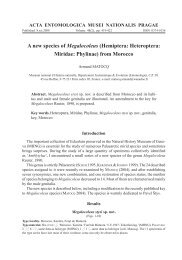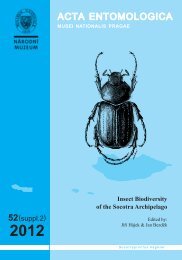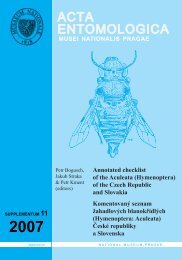Stysiofulvius, a new genus of Cylapinae - Acta Entomologica Musei ...
Stysiofulvius, a new genus of Cylapinae - Acta Entomologica Musei ...
Stysiofulvius, a new genus of Cylapinae - Acta Entomologica Musei ...
You also want an ePaper? Increase the reach of your titles
YUMPU automatically turns print PDFs into web optimized ePapers that Google loves.
ACTA ENTOMOLOGICA MUSEI NATIONALIS PRAGAE<br />
Published 8.xii.2008 Volume 48(2), pp. 377-384 ISSN 0374-1036<br />
<strong>Stysi<strong>of</strong>ulvius</strong>, a <strong>new</strong> <strong>genus</strong> <strong>of</strong> <strong>Cylapinae</strong><br />
(Hemiptera: Heteroptera: Miridae)<br />
from the Peninsular Malaysia<br />
Jacek GORCZYCA 1) & Frédéric CHÉROT 2)<br />
1)<br />
Department <strong>of</strong> Zoology, Silesian University, Bankowa 9, PL-40-007 Katowice, Poland;<br />
e-mail: jacek.gorczyca@us.edu.pl<br />
2)<br />
Systematic and Animal Ecology, Department <strong>of</strong> Animal Biology, Free University <strong>of</strong> Brussels, C.P. 160/13,<br />
av. F. D. Roosevelt, 50, BE-1050 Brussels, Belgium; e-mail: fcherot@ulb.ac.be<br />
Abstract. <strong>Stysi<strong>of</strong>ulvius</strong> gen. nov., a <strong>new</strong> <strong>genus</strong>, and S. hulinkai sp. nov., a <strong>new</strong><br />
species <strong>of</strong> the plant bug subfamily <strong>Cylapinae</strong> are described from Malaysia.<br />
Illustrations <strong>of</strong> the dorsal habitus <strong>of</strong> the male and genitalic structures <strong>of</strong> both<br />
sexes are given.<br />
Key words. Heteroptera, Miridae, <strong>Cylapinae</strong>, taxonomy, <strong>new</strong> <strong>genus</strong>, <strong>new</strong> species,<br />
Malaysia<br />
Introduction<br />
Members <strong>of</strong> the mirid subfamily <strong>Cylapinae</strong> are known to occur predominantly in tropical<br />
and subtropical regions <strong>of</strong> the world. More than 360 described species in 80 genera are<br />
known in this subfamily (HENRY & PAULA 2004, GORCZYCA 2006, MOULDS & CASSIS 2006,<br />
GORCZYCA & WOLSKI 2007). Most <strong>of</strong> them are reported from the Neotropical, Oriental and<br />
Afrotropical Regions. Their biology, distribution pattern and taxonomic richness are still in<br />
great need <strong>of</strong> investigation. Every year <strong>new</strong> taxa <strong>of</strong> <strong>Cylapinae</strong> are described from various<br />
warm regions <strong>of</strong> the World.<br />
Many <strong>of</strong> them inhabit rotten logs covered with fungi or bark <strong>of</strong> fallen trees. Some are<br />
collected on orchids and other flowers. Although cylapines are considered mycophagous<br />
and/or zoophagous, their biology is little known (WHEELER 2001, GORCZYCA 2006, YASUNAGA<br />
& MIYAMOTO 2006).<br />
Within the material collected in Malaysia and preserved in the Naturhistorishes Museum<br />
in Vienna, the senior author found five specimens <strong>of</strong> the subfamily <strong>Cylapinae</strong> which represent<br />
a <strong>new</strong> <strong>genus</strong> and a <strong>new</strong> species. The descriptions <strong>of</strong> the <strong>new</strong> taxa are given below.
378<br />
GORCZYCA & CHÉROT: <strong>Stysi<strong>of</strong>ulvius</strong>, a <strong>new</strong> <strong>genus</strong> <strong>of</strong> <strong>Cylapinae</strong> from Malaysia<br />
Taxonomy<br />
<strong>Stysi<strong>of</strong>ulvius</strong> gen. nov.<br />
Type species. <strong>Stysi<strong>of</strong>ulvius</strong> hulinkai sp. nov., here designated.<br />
Description. Macropterous. Body stout, smooth, covered with fine setae.<br />
Head contiguous with the anterior margin <strong>of</strong> pronotum. Frons flat; clypeus short and narrow;<br />
vertex with an occipital carina. Antennae inserted on small tubercles contiguous with<br />
the inner margin <strong>of</strong> eyes. First antennal segment thin, short, thickened towards apex; second<br />
antennal segment club-like, covered with thick setae; third and fourth segments thin, covered<br />
with fine long and short protruding setae; fourth antennal segment divided medially. Rostrum<br />
relatively long, reaching beyond metacoxae; first segment distinctly thicker than second.<br />
Pronotum broad, anterior lobe <strong>of</strong> pronotum convex, with a small, longitudinal sulcus in<br />
the middle, posterior and lateral margins rounded, humeral angles slightly elevated. Anterior<br />
angles with a small tubercle bearing a long bristle. Mesoscutum well exposed; scutellum<br />
slightly convex.<br />
Hemelytra lacking wide and deep punctation but provided with small orange yellow callosities<br />
or patches, covered with fine setae; medial fracture and R + M very short (Fig. 1);<br />
costal fracture distinct; cuneus short, broad.<br />
Ventral surfaces. Forefemora enlarged, covered with a row <strong>of</strong> thick protruding setae in the<br />
inner part; meso- and metafemora covered with dense, short setae. Meso- and metafemora<br />
bearing only three and four trichobothria respectively. Tibiae and tarsi covered with short<br />
setae. Tarsi two-segmented, first segment very short, second segment divided by an oblique<br />
suture; claws with a very small, hardly visible subapical tooth.<br />
Male genitalia. Parameres distinctly asymmetrical; phallus membranous, with sclerotised<br />
spiculi (Figs. 2-4).<br />
Female genitalia. Vagina complex including numerous sclerites. Inter-ramal sclerites (=<br />
A- structures) transversally subdivided by a membranous area.<br />
Etymology. This <strong>genus</strong> is dedicated to our friend Pr<strong>of</strong>. Pavel Štys in recognition <strong>of</strong> his<br />
invaluable contribution to the study <strong>of</strong> Heteroptera. It is named for Stys in combination with<br />
‘-fulvius’.<br />
<strong>Stysi<strong>of</strong>ulvius</strong> hulinkai sp. nov.<br />
(Figs. 1-7)<br />
Type locality. West Malaysia, Perak State, Banjaran Titi Wangsa Ringlet.<br />
Type material. HOLOTYPE: , ‘Holotype <strong>Stysi<strong>of</strong>ulvius</strong> hulinkai n. gen. n. sp. // Malaysia W., Perak / 40 km SE <strong>of</strong><br />
Ipoh / 900 m, Banjaran Titi Wangsa Ringlet, 29 iii – 15 iv. 2004 / Čechovský Petr lgt.’ (Naturhistorisches Museum<br />
in Vienna, Austria). PARATYPES: , ‘Paratype <strong>Stysi<strong>of</strong>ulvius</strong> hulinkai n. gen. n. sp.’ // same data as holotype (Coll.<br />
Department <strong>of</strong> Zoology, University <strong>of</strong> Silesia, Katowice, Poland); , ‘Paratype <strong>Stysi<strong>of</strong>ulvius</strong> hulinkai n. gen. n. sp.<br />
// Malaysia West, Pahang, Cameron Highlands, Tanah Rata, 1200-1500 m, 3. ii. – 19. ii 2005, Čechovský Petr lgt.’<br />
(Department <strong>of</strong> Zoology, University <strong>of</strong> Silesia, Katowice, Poland); , ‘Paratype <strong>Stysi<strong>of</strong>ulvius</strong> hulinkai n. gen. n.<br />
sp. // Malaysia W., Kelantan / Road between Kampong Raja / and Gua Musang 1400 – 1700 m / (Ladang Pandrak),<br />
1.-28. iv.2006 / 4°62′ N - 101°45′ E / 4°88′ N - 101°95′ E. / Čechovský Petr lgt.’ (Naturhistorisches Museum in<br />
Vienna, Austria).
<strong>Acta</strong> <strong>Entomologica</strong> <strong>Musei</strong> Nationalis Pragae, 48(2), 2008 379<br />
Fig. 1. <strong>Stysi<strong>of</strong>ulvius</strong> hulinkai gen. nov. and sp. nov. Male (holotype), dorsal habitus.<br />
Description. Male. Body dark brown with yellow spots, lines and patches. Length <strong>of</strong> the<br />
body 3.0-3.12 mm, width 1.32-1.34 mm.<br />
Head dark brown with four pale dots on vertex and frons and a W-shaped pale line above<br />
clypeus. Clypeus, maxillary and mandibulary plates brown with small pale patches. Length <strong>of</strong><br />
head 0.45 mm, width 0.70 mm, diameter <strong>of</strong> eye 0.20 mm. First antennal segment pale at base,<br />
then pale brown, apical part covered with pale and brown setae. Second segment pale brown at<br />
base and apex, covered with dense, dark setae. Third and fourth segments thin, dark, covered<br />
with long brown and short pale setae. Lengths <strong>of</strong> first to fourth antennal segments in mm:<br />
0.30 : 0.64 : 0.44 : 0.42. First rostral segment chestnut; remaining segments dark brown.
380<br />
GORCZYCA & CHÉROT: <strong>Stysi<strong>of</strong>ulvius</strong>, a <strong>new</strong> <strong>genus</strong> <strong>of</strong> <strong>Cylapinae</strong> from Malaysia<br />
Figs. 2-4. <strong>Stysi<strong>of</strong>ulvius</strong> hulinkai gen. nov. and sp. nov. Male genitalia (paratype). 2 – left paramere; 3 – right paramere;<br />
4 – phallus.<br />
Pronotum. Anterior lobe <strong>of</strong> pronotum dark brown, only the anterior margin with a thin,<br />
yellow stripe, posterior lobe dark brown, sometimes slightly tinged with red, with six short,<br />
pale, longitudinal stripes. Length <strong>of</strong> pronotum 0.52 mm, length <strong>of</strong> anterior margin 0.55 mm,<br />
lateral margins 0.50 mm, posterior margin 1.05-1.07 mm.<br />
Mesoscutum dark brown, paler on sides. Scutellum dark brown, shining, with pale yellow<br />
apex.<br />
Hemelytra dark brown, with numerous small, pale yellow spots and patches. Medial<br />
fracture, R + M, margin <strong>of</strong> corium and claval suture pale yellow apically. Clavus dark brown<br />
with numerous small spots; margins along scutellum pale. Clavus brown, pale at apex, with<br />
a pale transverse line along costal fracture. Membrane dark grey; venation dark; major cell<br />
rounded; minor cell indistinct in all available specimens.<br />
Ventral surfaces. Body dark brown ventrally, coxae and trochanters dark brown; femora<br />
brown with a paler patch near the apical part, apex sometimes tinged with red. Tibiae brown,<br />
darker than femora, with a contrasting pale, broad ring near the apical part (Fig. 1); tarsi pale<br />
brown.
<strong>Acta</strong> <strong>Entomologica</strong> <strong>Musei</strong> Nationalis Pragae, 48(2), 2008 381<br />
Figs. 5-7. <strong>Stysi<strong>of</strong>ulvius</strong> hulinkai gen. nov. and sp. nov. Female genitalia (paratype). 5 – vagina in dorsal view (abbreviations<br />
in the text); 6 – parieto-vaginal ring in latero-dorsal view; 7 – posterior wall in so-called dorsal view.
382<br />
GORCZYCA & CHÉROT: <strong>Stysi<strong>of</strong>ulvius</strong>, a <strong>new</strong> <strong>genus</strong> <strong>of</strong> <strong>Cylapinae</strong> from Malaysia<br />
Male genitalia. Left paramere with a small sharp process; right paramere slender (Figs. 2-<br />
3). Phallus membranous, with sclerotized spiculi (Fig. 4).<br />
Female. Similar to male. Length <strong>of</strong> the body 3.12 mm, width 1.52 mm. Length <strong>of</strong> head<br />
0.50 mm, width 0.75 mm, diameter <strong>of</strong> eyes 0.17 mm. Lengths <strong>of</strong> antennal segments in mm:<br />
0.30 : 0.55 : 0.57 (fourth segment broken in the specimens examined). Length <strong>of</strong> pronotum<br />
0.62 mm, length <strong>of</strong> anterior margin 0. 57 mm, lateral margins 0.52 mm, posterior margin<br />
1.12 mm.<br />
Female genitalia. Vagina particularly complex (Fig. 5), including numerous sclerites.<br />
Parieto-vaginal rings difficult to see in dorsal view, classical in latero-dorsal view (Fig. 6).<br />
Posterior margin (PmPv) <strong>of</strong> each ring narrow, its outer extremity in dorsal view partially<br />
hidden by a wide sclerites (S1). Latero-outer margin (LoPv) narrow, probably forming wide<br />
sclerites S1 posteriorly. Dorsal margin (Dpv) narrow, narrower on its inner part. Latero-inner<br />
margin (LiPv) relatively wide, sigmoid, partially hidden in dorsal view by a sclerite (S2)<br />
also partially obscuring the bulb. Dorsal wall (Dw) large, with two fields (F) <strong>of</strong> small teeth.<br />
Lateral oviducts (Ol) elongated. Dorsal wall lined by a complex <strong>of</strong> sclerites S3, partially<br />
hidden in dorsal view by parieto-vaginal ring and sclerites S2. A short and narrow sclerite<br />
S4 in dorsal view seems to join together the sclerites S2. Anterior or seminal sac (Ss) large,<br />
lacking sclerites. Anterior margin <strong>of</strong> dorsal labiate plate (AmDLP) very wide. Posterior wall<br />
(Fig. 7) very unique in shape. Inter-ramal sclerites (= A structures, AS) transversally subdivided<br />
by a membranous area (MA). Inter-ramal sclerites not subdivided longitudinally by a<br />
median process (= B structure), in the so-called dorsal part <strong>of</strong> the wall (below on our Fig. 7)<br />
but subdivided in the so-called ventral part (arrow). Inter-ramal lobes (= E structures, ES)<br />
large. Lateral lobe (= H structure) absent.<br />
Etymology. This species is dedicated to Jacek Hulinka, a friend <strong>of</strong> the senior author.<br />
Distribution. West Malaysia.<br />
Discussion<br />
The relationships <strong>of</strong> the <strong>new</strong> <strong>genus</strong> in the tribe Fulviini are still unclear. The <strong>new</strong> <strong>genus</strong> is<br />
superficially similar to Peritropis Uhler, 1891 and Terat<strong>of</strong>ulvidius Gorczyca & Chérot, 2001<br />
in its habitus. <strong>Stysi<strong>of</strong>ulvius</strong> gen. nov., however, can be easily distinguished from the former<br />
by the club-like second antennal segment (Fig. 1) and from the latter by the hemelytra lacking<br />
the wide and deep punctation but provided with small orange yellow callosites or patches.<br />
Asymmetrical parameres and membranous phallus with spicula are not uncommon in<br />
<strong>Cylapinae</strong>, particulary in the <strong>genus</strong> Fulvius, the largest <strong>genus</strong> <strong>of</strong> the tribe Fulviini. In the<br />
absence <strong>of</strong> robust phylogenetic hypotheses, these male genital character states do not help to<br />
asses relationships <strong>of</strong> <strong>Stysi<strong>of</strong>ulvius</strong>.<br />
By its female genital structures <strong>Stysi<strong>of</strong>ulvius</strong> could be hypothesized as close to the<br />
Cylap<strong>of</strong>ulvius-group <strong>of</strong> genera (CHÉROT & GORCZYCA 1999). Unfortunately, it is particularly<br />
difficult to homologize the different sclerites <strong>of</strong> female genital structures. GORCZYCA & CHÉROT<br />
(1998) described two paired sclerites <strong>of</strong> the medio-posterior lobe <strong>of</strong> the vagina <strong>of</strong> several
<strong>Acta</strong> <strong>Entomologica</strong> <strong>Musei</strong> Nationalis Pragae, 48(2), 2008 383<br />
Rhinomiridius Poppius, 1909 species: the so-called inner- and outer dorso-lateral plates<br />
(cf. also SADOWSKA-WODA et al. 2006: 618, Fig. 1). CHÉROT & GORCZYCA (1999) homologized<br />
both Cylap<strong>of</strong>ulvius’ and Cylap<strong>of</strong>ulvidius’ paired sclerites with Rhinomiridius’ outer dorsolateral<br />
plates. However, because only one paired sclerite is present in Cylap<strong>of</strong>ulvius and<br />
Cylap<strong>of</strong>ulvidius, the sclerites could be outer- or inner dorso-lateral plates. The absence <strong>of</strong> a<br />
second paired sclerite made a topological comparison impossible.<br />
Sclerite S2 <strong>of</strong> <strong>Stysi<strong>of</strong>ulvius</strong> could be homologous to the so-called outer dorso-lateral plate<br />
<strong>of</strong> several Cylap<strong>of</strong>ulvidius species (for example C. thailandicus Chérot & Gorczyca, 1999 and<br />
C. lineolatus Chérot & Gorczyca, 1999, cf. CHÉROT & GORCZYCA 1999: 220, Figs. 20-21 and<br />
corresponding text) or homologous to the inner dorso-lateral plate <strong>of</strong> Rhinomiridius species<br />
(cf. GORCZYCA & CHÉROT 1998: 52, Figs. 89-91) by its relative position and shape.<br />
Sclerite S3 <strong>of</strong> <strong>Stysi<strong>of</strong>ulvius</strong> could be homologous to the outer dorso-lateral plate <strong>of</strong> Rhinomiridius<br />
species and S4 homologous to the dorso-medial plate <strong>of</strong> the same <strong>genus</strong>.<br />
The posterior wall <strong>of</strong> the bursa copulatrix is still more problematical because it is normally<br />
a membranous structure in the <strong>Cylapinae</strong> and lacks noticeable sclerites, or provided<br />
with several teeth or reinforced margins. In some species <strong>of</strong> Vannius-complex sensu CASSIS<br />
et al. 2003 (particularly in the genera Austrovannius Cassis, Schwartz & Moulds, 2003 and<br />
Vannusioides Carvalho & Lorenzato, 1978, cf. CASSIS et al. 2003), it is possible to recognize<br />
two parts in the posterior wall: the inter-ramal sclerites and inter-ramal lobes sensu DAVIS<br />
(1955) [A and E structures sensu SLATER (1950)]. In Rhinomirini, by contrast, it is possible<br />
to recognize the inter-ramal sclerites, the median process and the posterior plate <strong>of</strong> the dorsal<br />
structure, however, the inter-ramal lobes are lacking. In some Fulviini (the genera Punctifulvius<br />
Schmitz, 1978 and Yamat<strong>of</strong>ulvius Yasunaga, 2000, cf. YASUNAGA 2000) it is possible<br />
to recognize the inter-ramal sclerite and the median structure (for a thorough discussion <strong>of</strong><br />
female genital structures in <strong>Cylapinae</strong> see SADOWSKA-WODA et al. (2006)). In the <strong>new</strong> <strong>genus</strong>,<br />
it is also possible to recognize at least two different sclerites: the inter-ramal sclerites and<br />
the inter-ramal lobes as in some species <strong>of</strong> Vannius-complex, but the former structures are<br />
atypically divided and a part <strong>of</strong> the median structure is probably present.<br />
In the absence <strong>of</strong> a good phylogenetic hypothesis for the genera <strong>of</strong> the tribe Fulviini, we<br />
cannot test our suggestions <strong>of</strong> primary homologies. Additional studies are needed to clarify<br />
relationships in the tribe.<br />
Acknowledgements<br />
We would like to express our sincere thanks to Herbert Zettel (Naturhistorisches Museum,<br />
Vienna) for the loan <strong>of</strong> specimens, Alfred G. Wheeler (Clemson University, Clemson, South<br />
Carolina) and Krystyna Warchał (University <strong>of</strong> Silesia, Katowice) for improvements in the<br />
language, Marzena Zmarzły (University <strong>of</strong> Silesia, Katowice), who prepared the drawing <strong>of</strong><br />
the dorsal habitus <strong>of</strong> the <strong>new</strong> species. Gerry Cassis (University <strong>of</strong> New South Wales, Sydney,<br />
Australia) and Tomohide Yasunaga (Rajamangala University <strong>of</strong> Technology, Suvarnabhumi,<br />
Thailand) provided helpful reviews <strong>of</strong> our manuscript.
384<br />
GORCZYCA & CHÉROT: <strong>Stysi<strong>of</strong>ulvius</strong>, a <strong>new</strong> <strong>genus</strong> <strong>of</strong> <strong>Cylapinae</strong> from Malaysia<br />
References<br />
CASSIS G., SCHWARTZ M. D. & MOULDS T. 2003: Systematics and <strong>new</strong> taxa <strong>of</strong> the Vannius complex (Hemiptera:<br />
Miridae: <strong>Cylapinae</strong>) from the Australian Region. Memoirs <strong>of</strong> Queensland Museum 49: 123-151.<br />
CHÉROT F. & GORCZYCA J. 1999: A <strong>new</strong> <strong>genus</strong> and four <strong>new</strong> species <strong>of</strong> <strong>Cylapinae</strong> from Indonesia, Laos and<br />
Thailand (Heteroptera, Miridae). Nouvelle Revue d’Entomologie 16: 215-230.<br />
DAVIS N. T. 1955: Morphology <strong>of</strong> the female organs <strong>of</strong> reproduction in the Miridae (Hemiptera). Annals <strong>of</strong> the<br />
<strong>Entomologica</strong>l Society <strong>of</strong> America 48: 132-150.<br />
GORCZYCA J. 2006: The catalogue <strong>of</strong> the subfamily <strong>Cylapinae</strong> Kirkaldy, 1903 <strong>of</strong> the World (Hemiptera, Heteroptera,<br />
Miridae). Monographs <strong>of</strong> the Upper Silesian Museum 5: 1-100.<br />
GORCZYCA J. & CHÉROT F. 1998: A revision <strong>of</strong> Rhinomiris-complex (<strong>Cylapinae</strong>) (Heteroptera: Miridae: <strong>Cylapinae</strong>).<br />
Polskie Pismo Entomologiczne 67: 23-64.<br />
GORCZYCA J. & WOLSKI A. 2007: A <strong>new</strong> species <strong>of</strong> the <strong>genus</strong> Peritropis from India (Heteroptera: Miridae:<br />
<strong>Cylapinae</strong>). Pp. 89-93. In: RENKER C. (ed.): Festschrift zum 70. Geburtstag von Hannes Günther. Mainzer<br />
Naturwissenschaftliche Archiv, Beiheft 31: 1-339.<br />
HENRY T. & PAULA A. S. 2004: Rhyparochromomiris femoratus, a remarkable <strong>new</strong> <strong>genus</strong> and species <strong>of</strong> <strong>Cylapinae</strong><br />
(Hemiptera: Heteroptera: Miridae) from Ecuador. Journal <strong>of</strong> the New York <strong>Entomologica</strong>l Society 112:<br />
176-182.<br />
MOULDS T. & CASSIS G. 2006: A review <strong>of</strong> Australian species <strong>of</strong> Peritropis (Insecta: Heteroptera: Miridae:<br />
<strong>Cylapinae</strong>). Memoirs <strong>of</strong> Queensland Museum 52: 171-190.<br />
SADOWSKA-WODA I., CHÉROT F. & GORCZYCA J. 2006: Contribution to the study <strong>of</strong> the female genitalia <strong>of</strong><br />
twelve Fulvius species (Heteroptera, Miridae, <strong>Cylapinae</strong>). Pp. 617-636. In: RABITSCH W. (ed.): Hug the Bug<br />
– For the love <strong>of</strong> true bugs. Festschrift zum 70. Geburtstag von Ernst Heiss. Denisia 19: 1-1184.<br />
SLATER J. A. 1950: An investigation <strong>of</strong> the female genitalia as taxonomic characters in the Miridae (Hemiptera).<br />
Iowa State College Journal <strong>of</strong> Science 25: 1-81.<br />
WHEELER A. G. Jr. 2001: Biology <strong>of</strong> the Plant Bugs (Hemiptera: Miridae). Pests, Predators, Opportunists. Cornell<br />
University Press, Ithaca, New York, 507 pp.<br />
YASUNAGA T. 2000: The Mirid subfamily <strong>Cylapinae</strong> (Heteroptera: Miridae), or fungal inhabiting plant bugs in<br />
Japan. Tijdschrift voor Entomologie 143: 183-209.<br />
YASUNAGA T & MIYAMOTO S. 2006: Second report on the Japanese cylapinae plant bugs (Heteroptera, Miridae,<br />
<strong>Cylapinae</strong>), with description <strong>of</strong> five <strong>new</strong> species. Pp. 721-735. In: RABITSCH W. (ed.): Hug the Bug – For the<br />
love <strong>of</strong> true bugs. Festschrift zum 70. Geburtstag von Ernst Heiss. Denisia 19: 1-1184.


